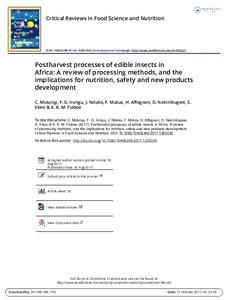| dc.contributor.author | Mutungi, C. |
| dc.contributor.author | Irungu, F.G. |
| dc.contributor.author | Nduko, J. |
| dc.contributor.author | Mutua, F. |
| dc.contributor.author | Affognon, Hippolyte D. |
| dc.contributor.author | Nakimbugwe, D. |
| dc.contributor.author | Ekesi, S. |
| dc.contributor.author | Fiaboe, K.K.M. |
| dc.date.accessioned | 2019-12-04T11:10:49Z |
| dc.date.available | 2019-12-04T11:10:49Z |
| dc.date.issued | 2017 |
| dc.identifier.citation | Mutungi, C., Irungu, F.G., Nduko, J., Mutua, F., Affognon, H.D., Nakimbugwe, D., ... & Fiaboe, K.K.M. (2017). Postharvest processes of edible insects in Africa: a review of processing methods, and the implications for nutrition, safety and new products development. Critical Reviews in Food Science and Nutrition, 1-23. |
| dc.identifier.issn | 1040-8398 |
| dc.identifier.uri | https://hdl.handle.net/20.500.12478/2274 |
| dc.description | Published online: 30 August 2017 |
| dc.description.abstract | In many African cultures, insects are part of the diet of humans and domesticated animals. Compared to conventional food and feed sources, insects have been associated with a low ecological foot print because fewer natural resources are required for their production. To this end, the Food and Agriculture Organization of the United Nations recognized the role that edible insects can play in improving global food and nutrition security; processing technologies, as well as packaging and storage techniques that improve shelf-life were identified as being crucial. However, knowledge of these aspects in light of nutritional value, safety, and functionality is fragmentary and needs to be consolidated. This review attempts to contribute to this effort by evaluating the available evidence on postharvest processes for edible insects in Africa, with the aim of identifying areas that need research impetus. It further draws attention to potential postharvest technology options for overcoming hurdles associated with utilization of insects for food and feed. A greater research thrust is needed in processing and this can build on traditional knowledge. The focus should be to establish optimal techniques that improve presentation, quality and safety of products, and open possibilities to diversify use of edible insects for other benefits. |
| dc.description.sponsorship | International Development Research Centre |
| dc.description.sponsorship | Australian Centre for International Agricultural Research |
| dc.format.extent | 1-23 |
| dc.language.iso | en |
| dc.subject | Entomophagy |
| dc.subject | Traditional Knowledge |
| dc.subject | Shelf Life |
| dc.subject | Packaging |
| dc.subject | Storage |
| dc.title | Postharvest processes of edible insects in Africa: a review of processing methods, and the implications for nutrition, safety and new products development |
| dc.type | Journal Article |
| dc.description.version | Peer Review |
| cg.contributor.affiliation | Egerton University |
| cg.contributor.affiliation | International Centre of Insect Physiology and Ecology |
| cg.contributor.affiliation | International Institute of Tropical Agriculture |
| cg.contributor.affiliation | University of Nairobi |
| cg.contributor.affiliation | International Crops Research Institute for the Semi-Arid Tropics |
| cg.contributor.affiliation | Makerere University |
| cg.coverage.region | Africa |
| cg.coverage.region | Central Africa |
| cg.coverage.region | East Africa |
| cg.coverage.region | Southern Africa |
| cg.coverage.region | West Africa |
| cg.coverage.country | Botswana |
| cg.coverage.country | Central African Republic |
| cg.coverage.country | Congo |
| cg.coverage.country | Congo, Dr |
| cg.coverage.country | Kenya |
| cg.coverage.country | Madagascar |
| cg.coverage.country | Nigeria |
| cg.coverage.country | South Africa |
| cg.coverage.country | Uganda |
| cg.coverage.country | Zambia |
| cg.coverage.country | Zimbabwe |
| cg.isijournal | ISI Journal |
| cg.authorship.types | CGIAR and developing country institute |
| cg.iitasubject | Biodiversity |
| cg.iitasubject | Post-Harvesting Technology |
| cg.journal | Critical Reviews in Food Science and Nutrition |
| cg.howpublished | Formally Published |
| cg.accessibilitystatus | Limited Access |
| local.dspaceid | 91869 |
| cg.targetaudience | Scientists |
| cg.identifier.doi | http://dx.doi.org/10.1080/10408398.2017.1365330 |

